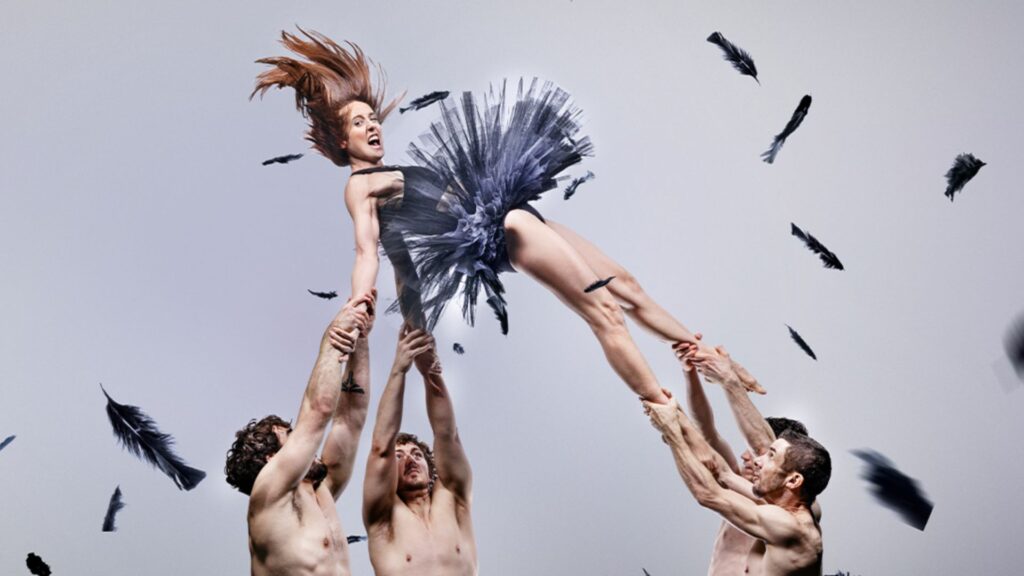By William Flockton and Taylor Brown

(Circa Ballet | CU Presents)
On a cool autumn evening, the audience in their suits and sweaters settled into their seats as their eyes settled onto the stage of Macky Auditorium. The lights went dark, and the theater fell into silence. Then in the darkness, a white spotlight illuminates a singular point to reveal the shadowy silhouette of a dancer behind the curtain. It opens, and the stage is washed in gold and white, as the Prince and his guests celebrate by standing on each other’s shoulders to form human towers, as their fellow performers enact a series of flips around them.
And so went the opening to the Australian Circa Contemporary Circus’s performance of the ballet, “Duck Pond,” on Oct. 5, officially marking the start of this year’s Artist Series.
For over 80 years, CU Presents has organized the Artist Series, bringing the best performances in classical music, jazz and performing arts to Macky Auditorium and the Boulder community. “Duck Pond” is the latest addition to these performances and was organized by the previous CU Presents Executive Director Joan Braun before his retirement.
“Duck Pond” is a circus reimagination of Tchaikovsky’s romantic ballet “Swan Lake” created by Yaron Lifschitz and the Circa ensemble. However, to describe “Duck Pond” as simply a pastiche of Tchaikovsky’s work would undercut Circa’s reinterpretation, which incorporates circus acrobatics and endearing comedy. The story of the Ugly Duckling ultimately diverges from the source material’s traditional narrative of prince charmings and heteronormative romance, creating a new, contemporary emphasis on the themes of self-discovery, the humorous unpredictability of life and the pursuit of love.
Ultimately, Circa’s willingness to go beyond the original and create a new story allows it to shine past Tchaikovsky’s work. This quality is found only in the best adaptations and reimaginings, which not only retell old stories, but do so in a way that fulfills the thematic needs of the modern day.
The ballet consists of three acts and a prologue. Within the first act, the Prince hosts a party featuring suspenseful stunts, with partygoers forming three-person towers among other acrobatics. From the seats, the performers could be seen trembling, as though at any moment they might collapse under their own weight, persevering against the forces of gravity, only falling back under its influence when they saw fit. Even Cupid made an appearance, as she ascended airol silk, only to pull it back as if she were knocking and releasing an arrow from a bow. Soon after the Prince and the Ugly Duckling, the ballet’s female lead, fall in love; however, the Ugly Duckling realizes that their love is not meant to be. The Ugly Duckling exits the stage in her sadness, and her romantic rival, the Black Swan, comes onto the stage to seduce the Prince.
In the second act, the Ugly Duckling, enraged by her own ugliness, rushes into a flock of swans, only to miraculously discover that she herself was a beautiful swan, and she just hadn’t realized it. She now believes that a romance with the Prince is possible, but finds that he has fallen in love with the Black Swan. The Ugly Duckling and the Black Swan confront each other, however, the love triangle does not come to the natural conclusion one might expect. Soon follows the third act with an even bigger surprise.
Leaving the original plot behind, the third act pursues a new story . . . or something like that. In the final act, the swans, ducks, cupids and party goers find themselves in a series of comedic and risqué events which illuminate the unpredictability of life and how true, feral enjoyment enables self-discovery.
While “Duck Pond” cannot properly be considered a spoof or parody, the performance carries the same care-free nature with its features of a nonsensical romance and a third act which totally diverges from the narrative established in the first two acts with some comedic, third-wall breaking physics. It is this dedication to the simplicity of play and entertainment that inspires a spring of joy and wonder within the audience and provides the greatest illustration of its themes.
Where Swan Lake fulfilled the conventions of the traditional fairy tale, with a cursed maiden and prince charming and a happy-ever-after, “Duck Pond” discards that plot entirely to explore aspects of self-fulfillment and life’s natural chaos. The timid Ugly Duckling does not find her curse broken by a male savior, but instead through the discovery that she was never cursed to begin with in an important act of self-realization. Furthermore, “Duck Pond” adds a layer of feminism in the narrative’s treatment of the Ugly Duckling’s romantic rival, the Black Swan. The Black Swan is a confident, dominating seductress, who is introduced using her legs to manipulate the body of her male co-performer. The character of the seductress is often portrayed as villainous and immoral, because she challenges the male lead’s own dominance and acts as an obstacle for the more traditional and submissive female lead. While “Duck Pond” does recognize the Black Swan as the female lead’s romantic rival, the Black Swan herself is never vilified or portrayed as lesser than due to her dominant sexuality. In fact, just like the female lead, the Black Swan does not have her happily-ever-after handed to her by the male lead.
The juxtaposition between the adherence to and disobedience to traditional conventions within ballet gives “Duck Pond” its charm. The use of slow-motion and fourth-wall breaks is intertwined with established ballet storytelling elements, making these additions seem only more brilliant. The greatest example of this is found in the ensemble of the Duck Army, the Ugly Duckling’s friends and the ballet’s main comedic relief. In the traditional ballet, the performers do not speak or make noise unless it is necessary, especially not members of an ensemble role, although there are some exceptions. “Duck Pond” is included in this list of exceptions, as the Duck Army’s inspired an enormous quantity of laughter as being the only members of the cast who were able to make noise, with their constant quacking and occasional screeches, one at the discovery of possessing a human foot inside her flipper shoe.
Comedy in ballet is not unique to “Duck Pond,” but it does demonstrate how the perception of ballet contrasts with that of other performing arts. Ballet carries an academic, mechanical stereotype with it. It is only when attending a performance that one is able to see the humanity in ballet: the small moments of comedy in the narrative, and the suspense as you wonder if the performer will fall as they balance and fly into the air. “Duck Pond” places a heavy emphasis on its comedic elements to humanize the genre of ballet and its own performance.
Many of the greatest stories are built on longstanding story conventions, such as the fairy tales of the Brothers Grimm and mythology. These tales have considerable staying power and are still compelling today. However, they also often perpetuate the biases of their time period which conflict with our own. Reinterpretation allows modern society to revitalize these stories with new, contemporary meanings, while criticizing outdated prejudices through the use of comedy.
“Duck Pond” exemplifies this in many ways, primarily in identifying what relationships are important in life. Circa critiques the original’s focus on heteronormative romance by placing greater emphasis on the relationship between the Ugly Duckling and the Duck Army ensemble. It instills the idea that friendships and self-respect are more important than romantic affection. The only way to love ourselves is by discovering our true identities through the aspect of having fun. While fun and games are not the only thing which leads to the Ugly Duckling’s discovery of her true identity, it is through fun and games that she receives comfort and is able to establish her new identity as the White Swan in the final act.
Ultimately, “Duck Pond” was a successful performance, receiving standing ovations and applause all throughout. In many cases, the audience would interrupt a scene with applause before it had even ended. Its divergence from Tchaikovsky’s original plot, and its contemporary themes, fit the essence of its location. After all, what greater goal is there for a university than adapting the past to the modern world?
Posted Oct.20

